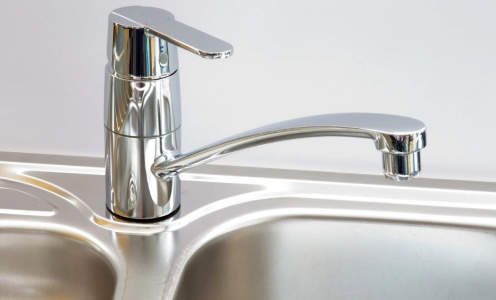Want to make an appointment with one of our expert plumbers? Get in touch!
As a homeowner, one of the things you should know is how to fix a leaking tap. Why is this important?
Forget the endless and irritating drip-drip-drip sound that comes with having a leaking tap, another problem is that it will cost you in wasted water if you don’t stop that tap from leaking.
Let’s find out how you can go about fixing leaky taps! But first, why did your tap begin leaking and what tools will you need if you’re going to stop your tap from leaking?
What to Know Before You Attempt Fixing Leaky Taps
The first thing to know before you fix a leaking tap is the reason for the dripping. It could be due to any of the following:
- The major culprits are usually deteriorating or broken washers
- A breach, crack or gouge in the tap seatings.
- The tap’s washer has become too hard to close fully, and this is what causes the dripping; because the tap is unclosed
- The tap washer is the wrong size or was installed incorrectly
- The jumper valve or valve seating is worn out
- The tap’s O-ring is loose or corroded
What Do You Need to Fix a Leaking Tap?
Now that you know what could cause your tap to leak, the next question would be how to fix the leaking tap.
Before we discuss the steps to stop a tap from leaking, you will need to have your basic tap fixing tools ready.
The best tool you can get is a tap fixing kit containing all the equipment you would need to fix your tap. You can get this from a plumbing store near you. However, if you cannot get hold of the tap fixing kit, don’t worry. Get each of these tools instead, and they will help you get the job done:
- A set of spanners or shifting wrenches (shifters). You may need different sizes of spanners in case the nuts on your taps are not the same size, or just an adjustable spanner.
- A set of pliers
- A washer and O-rings or tap cartridge to replace your damaged one. Ensure that you get the correct size that matches the damaged washer.
You need to know the type of tap that you have. This will determine if you need to replace a damaged washer or a damaged cartridge.
If what you have installed is a traditional tap, then you need a washer. Traditional taps have washers and O-ring seals, and the dripping may be as a result of damage to either or both.

But if what you have is a flick mixer tap, then what you need is a new cartridge. Flick mixer taps have cartridges instead of washers.

Steps to Take to Fix a Leaking Tap
Once you have the tools, fixing leaky taps is the next step. So, to stop the tap from leaking, take the following steps:
1. Turn off the water supply system:
The first thing to do is to turn off the system that is responsible for the flow of water to the tap. This will ensure that water does not keep running and cause a mess while you are carrying out the repairs. You can do this by turning off the tap at your water meter, or the isolation valve that controls the leaking tap.
Once done, then turn on the tap to remove any remaining water in the tap pipes.
2. Remove the tap handle and any other decorative parts of the tap:
Put these parts in a safe place, a ziplock bag, or some other isolated area or worktable. This is to ensure that no part is missing and you can assemble your tap properly once you are done fixing the leak.
You may need a screwdriver to do this, depending on the kind of tap you have. For some taps, all you need to do is to unscrew the button at the top of the tap, and the handle will come off. If the button proves difficult, you may need to lubricate it.
As you remove any part of your tap, ensure that you note the arrangement of the parts so that you do not have a difficult time when you have to put them back together again.
3. Remove the Skirt, Shroud, or Cover plate:
For some taps, this part will come off by itself once you remove the handle. For others, you will need to unscrew it with a spanner. If it is held in place by adhesives, you may need a set of pliers to pry it off.
You may also need to remove the tap bonnet with a spanner or shifting wrench.
Whatever you disassemble, make sure that you note how it was placed before removing it. This will help you when you have to put the tap together again.
4. Replace the damaged washer, cartridge or O-ring:
After removing the skirt, tap bonnet or shroud, you will see the damaged washer, cartridge or O-ring. Remove this carefully, and replace it with the new one you purchased. Clean up any debris you find in this area. Accumulated debris can cause damage to your tap washer, cartridge or O-ring.
5. Reassemble your tap:
Once you have replaced the damaged part of your tap, you have to put the tap back together as you removed them.
Having replaced the jumper valve and its washer, screw the stem back into the base on top of them. Put together the other parts with the same method. Try turning the tap on to make sure it’s all working properly.
Get Quality Plumbing Services to Fix Your Leaking Tap on the Gold Coast
If you’ve taken all the steps given above and your tap keeps leaking, or this whole process completely overwhelms you, then it’s time to call the experts. Your continuous attempts to fix it could worsen the damage, which could incur additional costs.
Thankfully, if you’re on the Gold Coast, you don’t have to keep searching for expert plumbers for leaky taps. At DCM Plumbing and Drainage, we’ve been providing customer friendly plumbing services for 20 years.
We will discover the cause of the leak in your tap, and in no time, ensure that the tap is fixed. Our plumbers work swiftly and efficiently with the required expertise and skill. You can be sure that your plumbing system is in the best hands.
Need quality plumbing services on the Gold Coast? Don’t hesitate. Call us on (07) 5576 5305, or contact us today!
If you’ve experienced cloudy water from your tap, it’s normal to be worried. It’s not what you want to see when you turn on your tap. After the initial concern of knowing it doesn’t quite look right, the second question that comes to mind might be – “Is it safe to drink?”
Here are some tips to take to ensure the water you drink is safe to drink.
WHAT CAUSES CLOUDY, WATER FROM A TAP?
In most cases, cloudy water is nothing to be overly concerned about. When the air bubbles try and escape, it causes a whitish colour. Cold water has a greater capacity to hold dissolved gases. When the cold water is sealed in pipes and under pressure and unable to escape, it can turn cloudy when the air escapes.
Turning the water tap on suddenly releases this high-water pressure, and the air is released as tiny bubbles in your water. As air is lighter than water, these bubbles float up and out of your water, leaving you with perfectly normal, clear and clean water. This is what gives your water a cloudy or milky appearance.
Your water should clear from the bottom to the top as the bubbles rise and escape.
IS CLOUDY WATER SAFE TO DRINK?
The good news is that if your water’s cloudiness is simply due to air bubbles, then your cloudy, white water is safe to drink. However, if your water looks cloudy or milky and it’s not clearing up after a while, then you might have a more severe problem that may need urgent attention.
THREE WAYS TO FIX CLOUDY TAP WATER
Clean a blocked aerator
The problem could be as simple as a blocked aerator which is what is screwed on to the end of the tap, creating a non-splashing stream and often delivering a mixture of water and air. This is a simple fix by giving it a clean and good scrub. Cleaning this could solve the problem temporarily, but it could become blocked again.
Replace the aerator
Replacing it with a new aerator is another option but if the aerator blocks again quickly, it may be time to call your local plumber to check for the cause.
Check your water supply
The final problem that might be causing your cloudy water is your water supplier. If work is being done in your area, they might turn off your water mains, so no new water enters the system. Air can get into the water mains during this time and dissolve in the water, causing the bubbles responsible for your cloudy water.
Unfortunately, when it comes to waiting for local councils, time frames can vary, and you may have to be patient. That air could stay in your water system anywhere from just a few hours to a few weeks!
If you’re ever concerned about your water source looking a different colour or not tasting quite right, the best action to take is to call a plumber to take a look.
Whether it’s a fix or a complete replacement of your water system or aerator, contact DCM Plumbing Gold Coast for the best service on the Gold Coast and get your water back to normal again!
If you’ve never fixed a leaking tap, don’t worry, you’re not alone, and it’s much easier than you might first think. A leaking tap can cause a lot of problems if not fixed quickly, including potentially damaging your home, wasting water and causing your water bill to skyrocket. The good news is that learning how to change a tap washer is all that is required in most cases to stop a tap from leaking.
If you’re unsure what a tap washer is, it’s the small disc that sits inside the tap that creates a seal to stop the water leaking. They can break down and wear out over time, but they are straightforward to replace. All you need to do once you have the old washer is go for a quick trip to the hardware store and show someone who will replace it with a new one of the correct size. But before you do this, here are a few steps on how to get to that stage first!
STEP 1: TURN OFF THE WATER AT THE MAIN
Locate where your main water meter is and switch it off. Most houses have it out the front of the house where the water meter is. You don’t want to mess with pipes and still have your water on.
STEP 2: HAVE YOUR TOOL KIT READY
If you don’t have a basic toolkit, it’s time to get one. For this job, you’ll need a few of the basics like spanners, pliers, screwdrivers, and a rag. If your tap is outside you can let it run to the ground but if it’s inside, grab a bucket or some old towels to mop up the excess water.
STEP 3: TURN ON THE TAP TO DRAIN THE PIPES
Once the main water is turned off, you’ll still have quite a bit of water in the pipes, and you’ll want to drain this out completely. If you tap is outside, let it drain onto the ground or catch it in a bucket to reuse on plants. If you’re inside let it flow through the sink till there are no drips left. The water should stop pretty quickly if your main has been turned off successfully.
STEP 4: LOOSEN THE TAP HEAD
Different taps will have different heads. If it’s a traditional outside tap, you’ll need to remove the spindle from the tap. This will require a spanner in most cases. If it’s wedged on hard, try using a spanner on the spindle head and one on the base to stop it moving. And loosen the spindle enough to take the head of the tap off. If it’s an inside tap, the tap might have a button that says ‘hot’ or ‘cold’ which will pop off with a screwdriver.
If you’ve got more modern-style tap, it may not even have washers inside as these are washerless, but it’s rare these will leak like older taps. These may have ball valves or ceramic discs. These usually have pivoting handles that control the water and will have an ‘O-ring’ that needs replacing rather than a washer.
STEP 5: TAKE OFF THE TAP HEAD AND HANDLE
Now you can take off the tap handle and head of the tap so you can have a good look inside the body of the tap. There will be a plastic of brass jumper value inside and inside this will be the washer. The washer may put straight out, or you might need tweezers to remove it.
STEP 6: BUY A NEW WASHER
Now you have the old washer; it’s time to take it to your hardware store and match a new one that is the correct size for your tap. If your jumper valve is undamaged, you’ll get away with just buying a new washer. Make sure you take the parts to the hardware store so they can help you buy the right parts if you’re not quite sure what to replace with.
STEP 7: REPLACE THE WASHER
Once back home, replace the new washer and put the jumper value back in place. Screw the tap bonnet or spindle back on and tighten it with a spanner.
STEP 8: TEST THE WATER FLOW
Once you’ve tightened the tap completely make sure the tap is turned to the off position. Then turn the water back on at the main source. Once the main is back on, test the tap when it’s turned on and off a few times. There shouldn’t now be any leaks or drips.
STEP 9: CONGRATULATE YOURSELF
If there are now no drips in the tap, you’ve done a great job, and you’ve successfully changed your tap washer.
However, if you’ve still got a leak or some drips, don’t despair! Give our friendly team at DCM plumbing a call straight away, and we will have one of our expert plumbers to your home to complete your job.

DCM Plumbing are family run team of professional plumbers. Our team is dedicated to supplying a professional plumbing and drainage service throughout the Gold Coast. We have been servicing residential and commercial properties since 2002 within Burleigh Heads and throughout the Gold Coast region.
- About Us
- Why Choose Us
- Meet Our Team
- Locations
- FAQ’s
- Who We Work With
- Residential
- Commercial
- Real Estates / Body Corporates / Strata Managers
- Builders

Google Rating
Based on 1429 reviews
©DCM Plumbing & Drainage 2025 All Rights Reserved
Terms and PrivacyGold Coast SEO & Design by Five by Five






